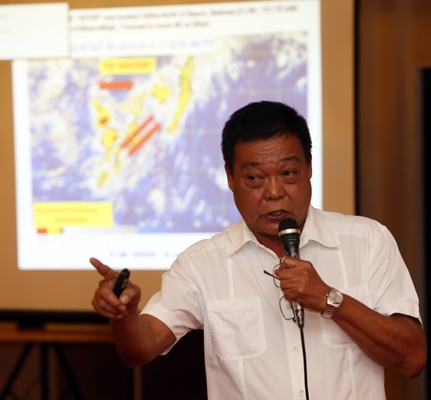
WATCH OUT. Despite the onset of the rainy season, water conservation is important as the rains will end after July until the early part of 2015 because of the El Nino, said Pagasa’s chief weatherman in the Visayas Oscar Tabada
Summer is over.
After almost a month of delay, the rainy season officially sets in yesterday.
The delay was an indicator that the El Niño weather phenomenon is forthcoming, according to chief meteorologist for the Visayas, Oscar Tabada of the Philippine Atmospheric, Geophysical and Astronomical Services Administration (Pagasa).
“This is not normal because the onset of the rainy season was supposed to start in the third or last week of May. But due to the El Niño it only started today (Tuesday),” Tabada said during his talk at a summit of government information officers in Region 7 yesterday.
The same weather pattern happened during the previous El Niño episodes in 2010 and 2003, Tabada added.
Rains are expected to fall in June and July, but will stop in August.
“During this time, people should start storing rainwater to prepare for the coming months,” he advised.
Save Water
By August, Pagasa forecast that there will be no more rains.
People will start to again feel extreme heat starting October, said Tabada.
Last month, the Pagasa Mactan Weather Station recorded 63.3 millimeters of actual rainfall when the average rainfall for the month is 95 millimeters.
As of June 9, only 52.2 millimeters of actual rainfall were recorded when the mean rainfall for this period should be 175.6 millimeters.
The dry season has also prompted the Metropolitan Cebu Water District (MCWD) to warn the public to prepare for the effects of El Niño.
The water district expects the extreme heat to affect its surface water sources, the Buhisan Dam and Jaclupan weir in Talisay City, which produces about 20 percent of MCWD’s total daily supply of about 40,000 cubic meters of water.
Once these surface water sources are affected, MCWD will implement a distribution management system in affected areas.
“MCWD is enjoining its consumers to conserve water,” said the water district in a statement.
It said that according to a Philippine Institute for Development Studies data, an average Filipino family uses six liters per capita per day for drinking and 12 for cooking.
Most water used in the the household is for personal hygiene at 68 liters per capita per day and 74 for sanitation services.
Consumers were also advised to regularly check faucets, toilets and pipes for leaks and have them repaired immediately and report them to MCWD.
The water district also said it is expecting additional water supply later this year which they hope will cushion the effects of the El Niño.
Supply of 32,010 cubic meters daily will be available later this year with the commissioning of five wells within the MCWD’s service area.
By the last quarter of the year, another 11,500 cubic meters daily will also be available from Abejo Waters Corp., MCWD’s private bulk water supplier.
An additional of 18,000 cubic meters of water daily is expected from a new connection to the Carmen Bulk Water Supply Project.